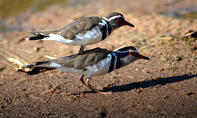
Name
Three-banded plover (Charadrius tricollaris)Three-banded Plover Appearance
The three-banded plover’s back, wings and the top of its head are brown. The face and underparts are white. This plover gets its name from the double black breast band. It has a white ring on its head, starting at the beak and circling the head, above the eyes. The beak is red with a black tip and a red eye ring is present.Three-banded Plover Diet
The three-banded plover's diet is mainly aquatic and terrestrial invertebrates.Three-banded Plover Breeding
The three-banded plover breeds throughout the year in South Africa and the time of the year changes according to water level and food supply. The female lays two eggs in a shallow scrape, normally on exposed gravel or mud flats, near water.
Both adults share the incubation and the chicks hatch after 28 days. The chicks are precocious and leave the nest the day after hatching. The chicks fledge at around 30 days.
Three-banded Plover Behaviour
Three-banded plover are normally found in loose flocks of up to 10 birds. When feeding they move in quick jerky short runs, stopping to probe the substrate with quick jabs or foot trembling.This plover is mostly sedentary, but will migrate on mass if the water levels drop.